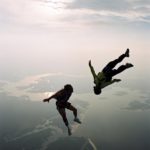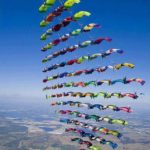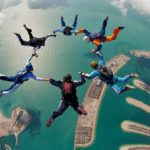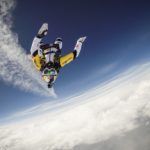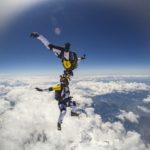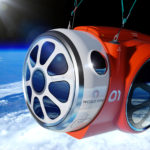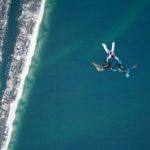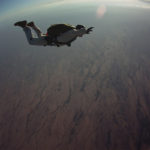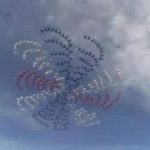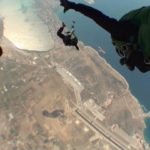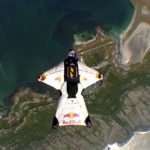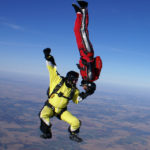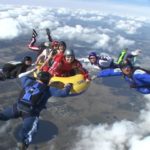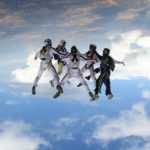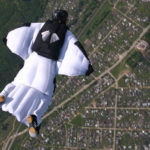parachuting (such as for evacuations), skydiving, sky-surfing, wing-suiting, and more (which is all preparation for our 19th grade; Inisfree’s Boot Camp)
–
Table of Contents:
- Introduction
- Vocabulary
- Progression
- Additional Notes
- Image Examples
–
Introduction:
Since graduating from LHS traditionally includes BASE-jumping off one of its ‘liberty spikes’, we offer to help all students here get used to skydiving in multiple ways from their formative years.
–
Vocabulary:
- AAD: The acronym AAD stands for Automatic Activation Device. You’ll most commonly hear this usually before walking to the airplane when an instructor asks their AFF student, “Is your AAD on?” The automatic activation
device is like an emergency backup computer. It reads barometric pressure and speed and will automatically deploy a reserve parachute if a skydiver crosses a predetermined altitude threshold (usually 750 feet) at a high speed. The computer recognizes that something is wrong at that low altitude and deploys the reserve. An AAD has saved hundreds of lives since it was first introduced to skydiving. The most common AAD’s used is the Cypress device and the Vigil. - AFF: The acronym AFF stands for Accelerated Free Fall course. AFF is the most modern form of skydive training which takes an individual from no experience to jumping on their own with the competence to handle emergency procedures, fall in the correct body position and to fly and land a parachute safely. AFF is the preferred method of training because it begins at the height of 12,000 feet allowing a new skydiver to immediately begin developing free fall techniques. The AFF Camp is a 9 stage program, designed to help you achieve the knowledge and various skills required to make a solo skydive unassisted.
Prior to AFF training, new skydivers would go through a form of training known as ‘static line’ which was focused on the body position on exit and flying the parachute. There was very little free fall experienced with static line because a ‘static line’ attached to the plane would deploy a new skydiver’s main parachute immediately after exiting resulting in a mere seconds of free fall. SA Skydiving also offers A License Packages for those wanting to streamline their progression. - A License: The A license is an internationally recognized license, that qualifies you to make a solo skydive at any FAA affiliated drop zone. Once you have complete the AFF program and you have landed a parachute successfully 10 times within a 30m target, you will be eligible for a A License. This is easily attainable with the tuition offered at SA Skydiving.
- APF: The governing body for skydiving in Australia is the APF – Australian Parachute Federation.
- ARCH: The arch position is the most common position in skydiving, as it allows skydivers to fall stable and in a belly to earth position. It also allows for a clean deployment of the main parachute. The arch position is head back, hips forward, legs at 45 degrees and toes pointed to the horizon. Your arms should be out in front and in your peripheral vision.
- B-REL: The learning stage for a skydiver after receiving an A License is the B-Rel Program. The B-Rel program teaches the finer points of skydiving with others. B-Rel students receive comprehensive one on one coaching with a specially qualified instructor.
- BOOGIE: A special multi-day skydiving event usually involving different aircraft, visiting load organizers, evening parties and loads of fun! A good example of this is the Funny Farm Boogie.
- CANOPY: A canopy is a parachute. Today, most people refer to their parachutes as canopies. A Canopy is mad up 9 individual cells, that inflate to form a wing. This wing is what allows skydivers to fly through the sky and return safely to the ground.
- CONTAINER: The container is the parachute harness that you wear. It contains the Main Parachute, Reserve Parachute and AAD.
- CRW: Pronounced ‘CREW’, Canopy Relative Work is a skydiving discipline whereby jumpers ‘link up’ with other skydivers while under parachute to create different formations. A great example of CRW is the recent Australian CRW National Record. Many who participate in CRW are known as CRW Dogs. Those learning the discipline are known as CRW Pups. Pictured above is what is known as an 8-stack.
- CURRENT: Staying current means actively jumping as not to become uncurrent. To “be current” is to have jumped recently enough to retain proficiency as defined by the Australian Parachute Federation. Uncurrent skydivers, depending on their experience, must be supervised to some degree when they resume jumping.
- CUTAWAY HANDLE: The cutaway handle is located on the right (when looking down at your handles). It does not contain any knifes or blades, but rather is a term used to describe the handle you pull to disconnect yourself from the main parachute in the event of a malfunction, and return into freefall, where by you can safely deploy your reserve parachute.
- DYTTER: A ‘Dytter’ is an audible altimeter made by the company Larsen & Brusgaard. The device is designed to ‘beep’ at pre-determined altitudes set by the skydiver. The Dytter is a reminder to skydivers of their altitudes and is excellent for ensuring a skydiver is altitude aware.
- DZ: A DZ stands for Drop Zone – the place one goes to make a skydive. Also known as a skydive center. Many may be familiar with the movie DropZone (perhaps the worst movie ever made about skydiving 😉
- DZSO: The Drop Zone Safety Officer is in charge of all safety-related matters at the skydiving center. A DZSO also determines if weather conditions are safe enough to skydive. If you have any questions regarding safety of training, direct them towards the DZSO. The DZSO for the day can usually be found on the whiteboard in the packing room.
- EXIT WEIGHT: The total weight of both the jumper and the equipment the jumper is wearing. Knowing one’s exit weight helps determine a skydiver’s wing loading (see below).
- FLARE: Flaring is the act of pulling down the toggles on your canopy in order to slow it down and make a soft, gentle landing.
- FS & RW: FS = formation skydiving. RW = relative work. Both of these terms mean the same thing – jumping with other skydivers in a belly to earth body position. The greatest FS / RW jump ever made is the current World Record 400-Way skydive set in 2006 in Thailand.
- GCO: The GCO stands for Ground Control Officer and they are in charge of all ground operations. The GCO is also sometimes referred to as manifest. This is the hub of the whole operations, and where you will book in for your skydives.
- IN DATE: A reserve parachute must be packed by a certified rigger every six months whether it is used or not. Skydivers are not permitted to make a skydive unless their reserve parachutes are ‘in date’ meaning they’ve been repacked within the last six months. A reserve that’s not been packed within the last six months is termed ‘out of date.’
- JM: The JM stands for Jump Master, or otherwise known as an Instructor.
- JUMP RUN: The flight path taken by the jump plane to put skydivers in position over the airport. Jump Run factors in wind speeds at different levels of altitude to allow drift of skydivers in free fall. The Jump Run may change from one flight to the next dependent on weather variables.
- LOADING HOT: A Plane Load that is ‘Loading Hot’ means the aircraft will not stop running after landing from the previous load of jumpers, and the jumpers will practice exits and emplane whilst the plane is running.
- LOAD ORGANIZER: A highly experienced skydiver who specializes in a specific skydiving discipline to help other skydivers improve their skill set. Load organizers are usually brought in for large boogies or skill development camps.
- RESERVE HANDLE: The Reserve Handle is located on your left (when looking down at your handles), and is the handle you pull to deploy your Reserve Parachute. The reserve parachute opens and behaves in exactly the same way as the main parachute.
- PLR: A PLR is a Parachute Landing Roll (sometimes referred to as a Parachute Landing Fall). All skydivers are trained to fall correctly if unable to stand up a landing. The PLR technique is designed to distribute the landing shock once landing. This technique was especially important and most commonly used by skydivers who jump round parachutes. The technique is still vitally important for those who fly square parachutes as different wind conditions may required a jumper to execute the maneuver in order to prevent injury. You will be taught this technique during your AFF Course.
- RISERS: Risers are the webbing that connect your suspension lines to the 3 – ring system on your container.
- RSL: RSL is an acronym for Reserve Static Line. An RSL is a backup device for automatically deploying the reserve if the skydiver cuts away their main canopy.
- SLIDER: The slider is a piece of fabric that helps to slow down the opening speed of the parachute at terminal velocity. It works by restricting the amount of air that is able to enter the parachute during the opening process. Once it has done its job, the slider will descend down the lines and end up just above your head.
- TA: The TA is your Target Assist. They are a qualified instructor that assists students in their landing pattern using Ground to Air communications such as radio’s or visual arrows.
- TERMINAL VELOCITY: The speed at which a skydiver falls when the friction of the air on their body is equal to and counter acts the force of gravity so that they no longer accelerate.
- TOGGLES: Toggles, otherwise referred to as ‘Brakes’, refer to the handles attached to the steering lines of the parachute. They are what you use to steer your parachute and ‘Flare’ your parachute. Your toggles are located on the rear of your rear risers.
- UPPERS: A term used for upper winds. Knowing what the upper winds are is important in order to calculate an accurate jump run. It’s not uncommon for upper winds to be at different wind speeds and directions than ground winds.
- UPWIND: Skydivers exit the aircraft in an upwind position from the landing area, as this allows and helps all skydivers to return to the landing area.
- VRW: VRW is Vertical Relative Work which is jumping with other skydivers in a head to earth body position. An excellent example of this is the recent VRW World Record Jump.
- WING LOADING: Wing loading is the loaded weight under a parachute divided by the area of the parachute.
- 3 RING SYSTEM: The 3 ring system is a system that allows a skydiver to quickly cutaway a malfunctioning main parachute with a single motion. The mechanics of the 3 ring system will be explained during the AFF course.
–
Progression:
Each of these altitude-increases is practiced numerous times, every time adding more specific hand-movements and other techniques for precision-falling/maneuvering. Eventually, at each altitude-bracket, all forms of skydiving are mastered; parachutes, paragliders, snowboard-parachute combos, etc.
General:
- from Civilian Aerospaceport to the Meadow(s) –only ~1 mile of freefall
- Rooftop Carriers a couple miles above ground-level
- BASE-jumping / wing-suiting from the Avalanche Wall‘s top (during Inisfreean wedding ceremonies)
- then Cloud City II‘s jump-borders/platforms
- Crow’s Nest position
- low-orbit from an Inisfreean Spacecraft
- mid-orbit from an Inisfreean Spacecraft
- high/distant-orbit from an Inisfreean Spacecraft
By School-year:
- Fan Room
- Moon Bounce –2024 April note: Our main moon-bounce is above ground-level, so we might have a basic one for the underground Batchling classroom/s.
- Trampoline
- Spring Board
- Foam Bin, Air Cushion
- Zip-line
- Bungee Jumping
- Hang-gliding
- Parasailing
- Skydiving
- Base Jumping
- Spelunking
- Exodus
- Wing-suiting
- HALO
- ODST
–
Additional Notes:
All ICVs participate in this course, and officially graduate by BASE-jumping off the top of LHS during their respective graduation day/s.
No non-ICV is required to skydive for any reason. Those non-ICVs who opt into this course always have an ICV present to instruct/help them.
–
–




